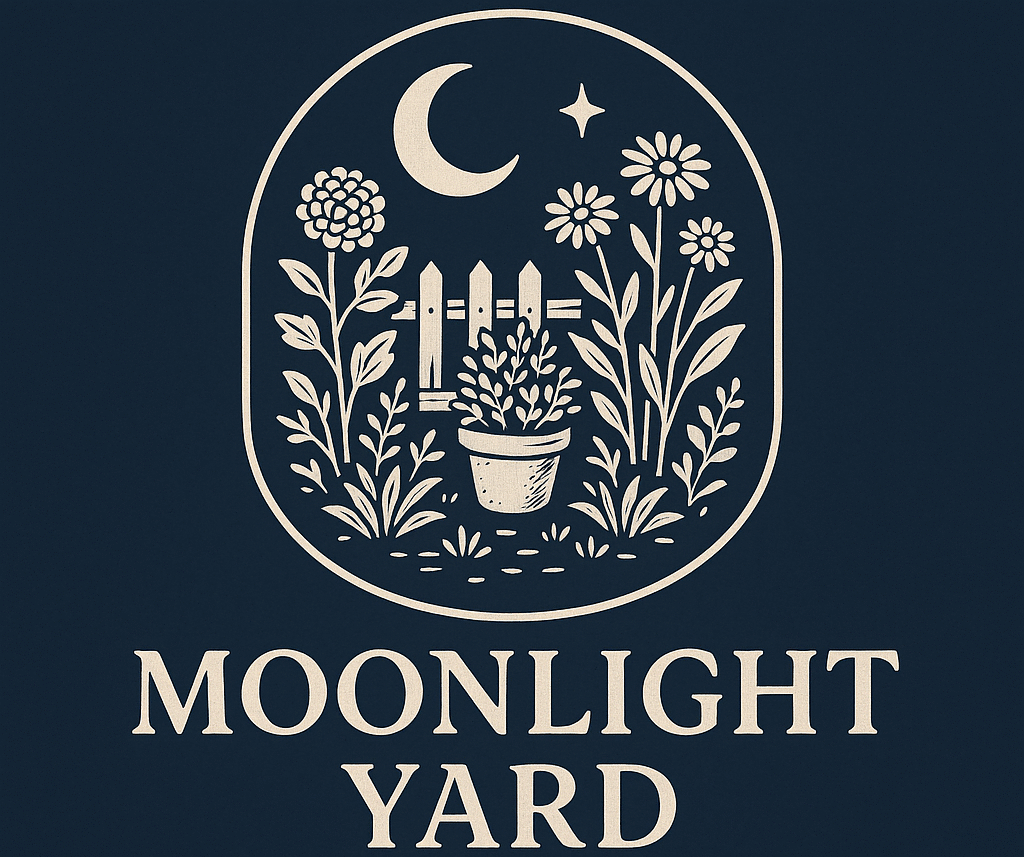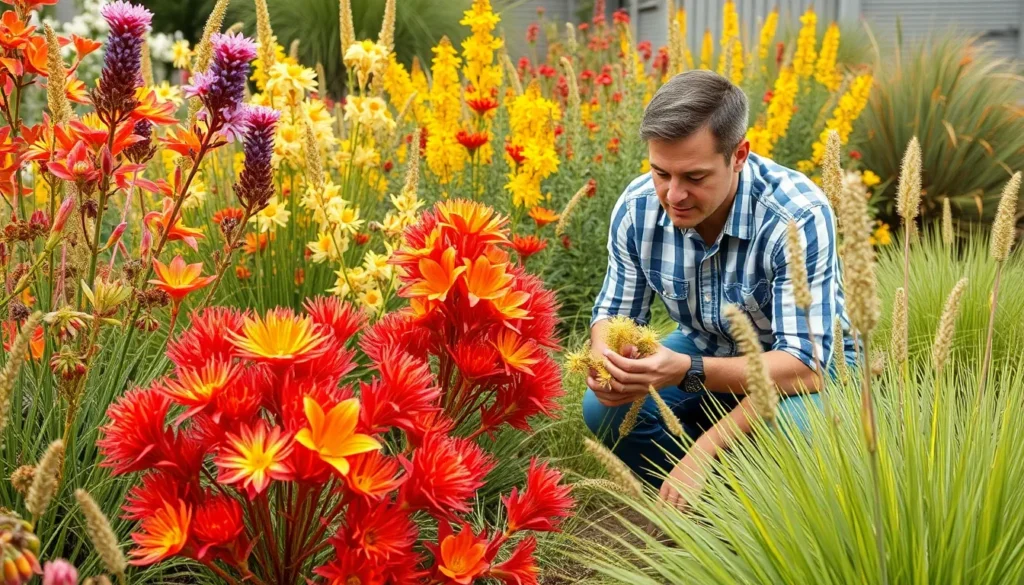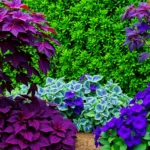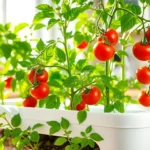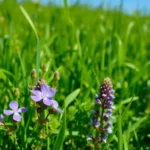Creating an Australian native garden transforms your outdoor space into a stunning sanctuary that’s both environmentally conscious and incredibly low-maintenance. We’ve discovered that native plants aren’t just beautiful—they’re perfectly adapted to Australia’s unique climate conditions and require significantly less water than traditional European garden varieties.
Native gardens offer endless possibilities for creative landscaping while supporting local wildlife and reducing your environmental footprint. From vibrant bottlebrush blooms to the silvery foliage of native grasses, these plants create year-round interest with minimal intervention. We’ll show you how native species can thrive in everything from coastal gardens to inland dry zones.
Whether you’re starting from scratch or transitioning your existing garden, incorporating Australian natives doesn’t mean sacrificing style or color. We’ve compiled practical ideas that’ll help you design a garden that’s uniquely Australian while being kind to both your wallet and the planet.
Create a Drought-Tolerant Foundation With Native Grasses
Native grasses form the backbone of sustainable Australian gardens, offering year-round structure while requiring minimal water once established. These resilient plants create natural movement and texture that transforms ordinary landscapes into ever-changing outdoor spaces.
Kangaroo Grass for Natural Movement
Kangaroo grass (Themeda triandra) brings graceful elegance to our native gardens with its distinctive purple-tinged seed heads that dance in the breeze. This iconic Australian grass grows 60-90cm tall and develops beautiful golden autumn colors that persist through winter months. We recommend planting kangaroo grass in clusters of 5-7 specimens to create stunning visual impact across larger garden areas.
Establishment requires well-draining soil and full sun exposure for optimal growth results. The grass tolerates poor soils exceptionally well and becomes completely drought tolerant after its first growing season. Regular watering during the initial 6-8 weeks helps develop strong root systems that later access deep moisture reserves.
Maintenance involves annual cutting back to 10cm height during late winter before new growth appears. This simple pruning encourages fresh shoots and maintains the plant’s compact form throughout the growing season.
Lomandra for Low-Maintenance Borders
Lomandra species create perfect structural elements for garden borders while requiring virtually no ongoing maintenance once established. These versatile grass-like plants grow in neat clumps ranging from 30cm to 1.5m depending on the variety selected. We particularly favor Lomandra longifolia ‘Tanika’ for its compact 40cm height and consistent performance in various soil conditions.
Planting spacing of 60-80cm between specimens allows proper air circulation while ensuring complete ground coverage within two growing seasons. Lomandra thrives in both full sun and partial shade positions, making it ideal for transitional areas between different garden zones. The plant’s blue-green foliage provides year-round color contrast against flowering natives and hardscape elements.
Watering requirements drop to zero after the establishment period, making lomandra perfect for water-wise landscaping projects. Occasional removal of old flower stalks keeps the plants looking tidy, though this task only needs attention once or twice yearly.
Wallaby Grass for Sloped Areas
Wallaby grass (Austrodanthonia species) excels on challenging slopes where erosion control meets aesthetic appeal. This fine-textured native grass forms dense mats that stabilize soil while creating soft, naturalistic coverage across difficult terrain. We’ve observed excellent results using wallaby grass on slopes up to 30-degree gradients where other plants struggle to establish.
Root systems penetrate deeply into slope faces, creating natural reinforcement that prevents soil movement during heavy rainfall periods. The grass grows 20-40cm tall depending on moisture availability and produces delicate seed heads that add seasonal interest to challenging industry areas. Multiple species within the Austrodanthonia genus allow us to select varieties suited to exact soil types and climate conditions.
Installation on slopes requires temporary erosion control measures such as jute mesh until grass coverage reaches 80% density. We recommend combining wallaby grass with native ground covers like Grevillea lanigera to create diverse plant communities that support local wildlife while maintaining slope stability.
Design Stunning Flower Displays With Native Blooms
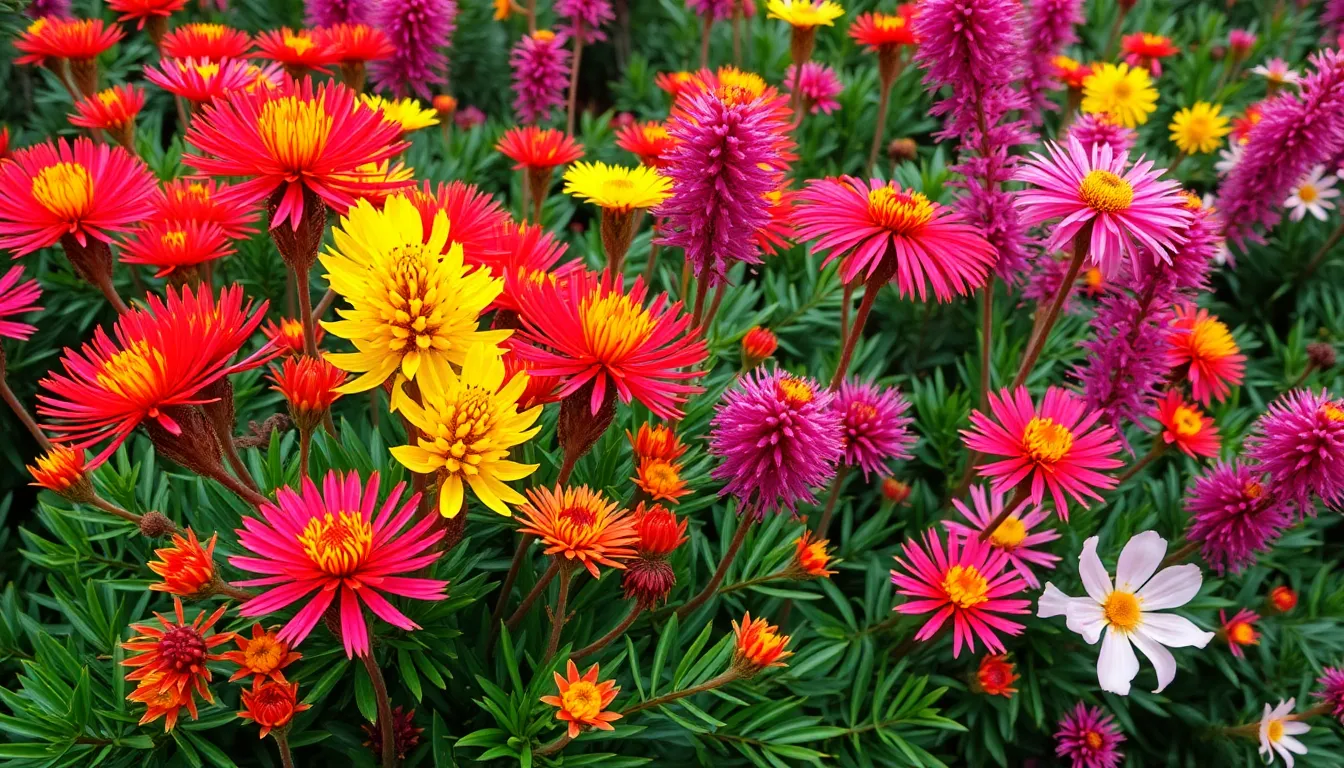
Native Australian plants deliver spectacular flower displays that outshine traditional garden varieties while requiring minimal maintenance. We can create vibrant landscapes using the country’s diverse flora, with over 800 Wattle species and 700 Eucalyptus varieties providing endless design possibilities.
Grevillea Varieties for Year Round Color
Grevillea transforms gardens with continuous blooms that span every season. These versatile shrubs produce flowers in stunning shades of red, pink, orange, yellow, and white, ensuring our landscapes maintain visual interest throughout the year. Spider flower grevilleas offer delicate, intricate blooms while toothbrush varieties create bold cylindrical displays. Planting different grevillea species with staggered flowering periods guarantees constant color in our native gardens. We recommend grouping three to five plants of the same variety for maximum visual impact, as their diverse flower shapes and colors complement each other beautifully.
Banksia Species for Bold Statement Pieces
Banksia integrifolia and other coastal banksia species create dramatic architectural elements in our garden designs. These robust plants develop sculptural forms that serve as natural focal points, particularly effective in coastal environments where they thrive naturally. Banksia flowers emerge as distinctive cylindrical spikes in golden yellows, deep oranges, and rich reds, creating striking contrasts against their serrated foliage. We position these bold specimens as standalone features or anchor plants in mixed native borders. Their substantial size and unique flower formations make them ideal for creating visual weight in large garden spaces.
Waratah for Show Stopping Focal Points
Telopea speciosissima commands attention with its magnificent crimson blooms that can reach 10 centimeters across. We strategically place waratahs where their vibrant red flowers create maximum impact during their spring flowering season. These iconic Australian natives work exceptionally well as specimen plants in prominent garden positions or as the centerpiece of native flower beds. Waratahs prefer well drained soil and partial shade, making them perfect for transitional areas between full sun and shadier garden zones. Their dramatic blooms last for several weeks, providing an unforgettable display that attracts both human admirers and native wildlife to our gardens.
Establish Natural Privacy Screens Using Native Shrubs
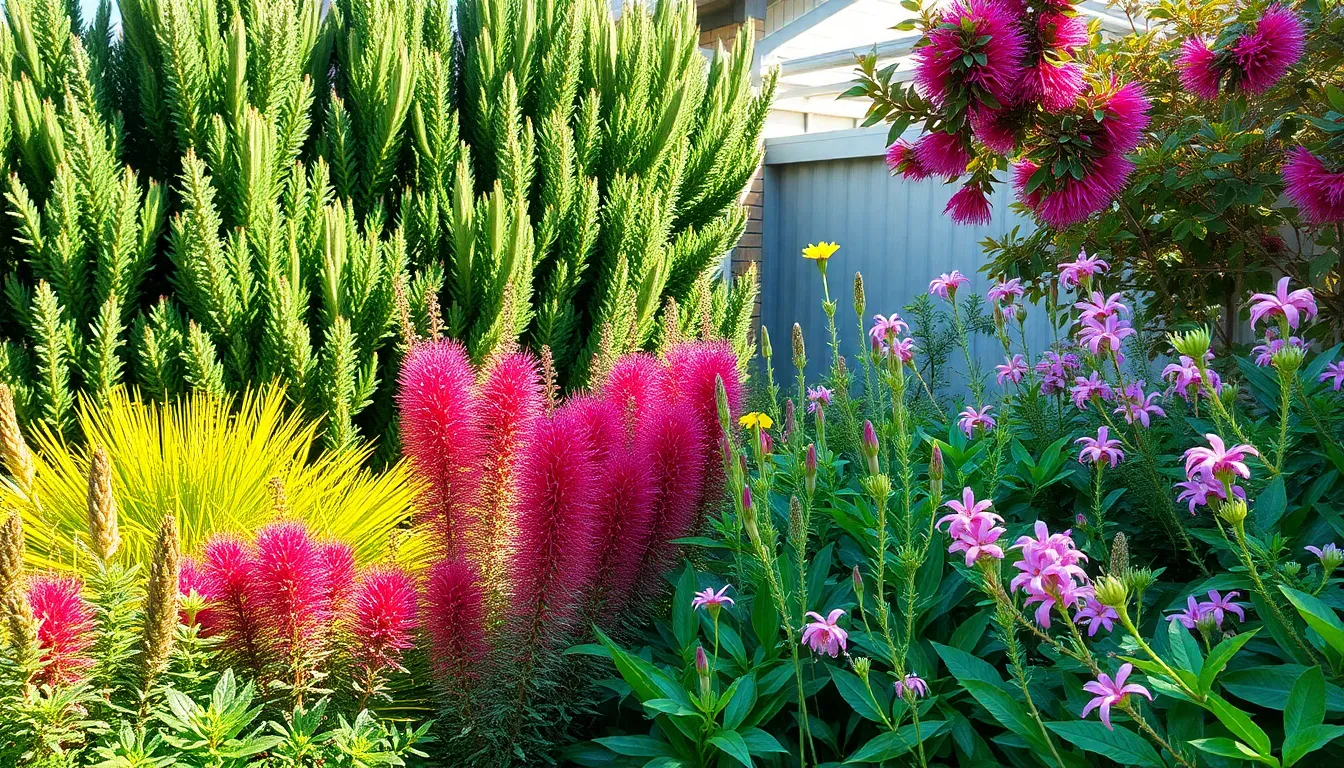
Creating effective privacy barriers doesn’t require sacrificing our commitment to native gardening. We can achieve both seclusion and sustainability by selecting the right Australian native shrubs for natural screening.
Lilly Pilly for Dense Evergreen Coverage
Lilly Pilly (Syzygium luehmannii) stands out as our top choice for establishing dense, year-round privacy screens. Dense evergreen foliage creates impenetrable barriers that maintain their coverage throughout all seasons, making this species particularly valuable for permanent screening answers.
Trimming these plants regularly helps maintain desired shapes and prevents overgrowth that could overwhelm smaller garden spaces. Planting Lilly Pilly specimens 1.5 to 2 meters apart ensures proper coverage while allowing adequate air circulation between plants. Growing conditions favor well-draining soil with moderate water requirements, making maintenance straightforward for most homeowners.
Establishing hedge formations with Lilly Pilly creates living walls that can reach heights of 3 to 6 meters when left untrimmed. Maintaining these natural screens requires minimal effort once established, with pruning needed only twice yearly to preserve shape and density.
Bottlebrush for Colorful Barriers
Bottlebrush (Callistemon citrinus) transforms functional privacy screens into vibrant industry features that attract beneficial wildlife. Bright blooms provide striking red cylindrical flowers that create visual interest while serving as effective barriers between property boundaries.
Attracting birds and other wildlife enhances biodiversity in our gardens, with Bottlebrush flowers serving as natural feeding stations for native species. Positioning these shrubs strategically creates colorful borders that bloom throughout spring and summer months. Spacing plants 2 to 3 meters apart allows for natural growth patterns while ensuring adequate screening coverage.
Flowering cycles typically occur from September through December, providing extended periods of vibrant color that complement other native plantings. Pruning immediately after flowering encourages bushier growth and promotes better screening density for the following season.
Native Fuchsia for Shaded Boundaries
Native Fuchsia (Correa spp.) excels in creating elegant privacy answers for shadier areas where other screening plants might struggle. Bell-shaped flowers add delicate beauty to boundary plantings while providing effective coverage in challenging growing conditions.
Thriving in partial to full shade makes Native Fuchsia our go-to solution for areas under tree canopies or alongside buildings. Producing tubular flowers in colors ranging from cream to deep red creates subtle yet attractive screening that doesn’t overwhelm surrounding plantings. Tolerating various soil conditions including clay and sandy soils increases placement flexibility throughout our garden designs.
Establishing these shrubs requires minimal soil preparation, making them ideal for quick privacy answers in difficult areas. Growing to heights of 1 to 2 meters provides adequate screening for most residential applications while maintaining manageable proportions for ongoing maintenance.
Build Habitat Gardens That Attract Local Wildlife
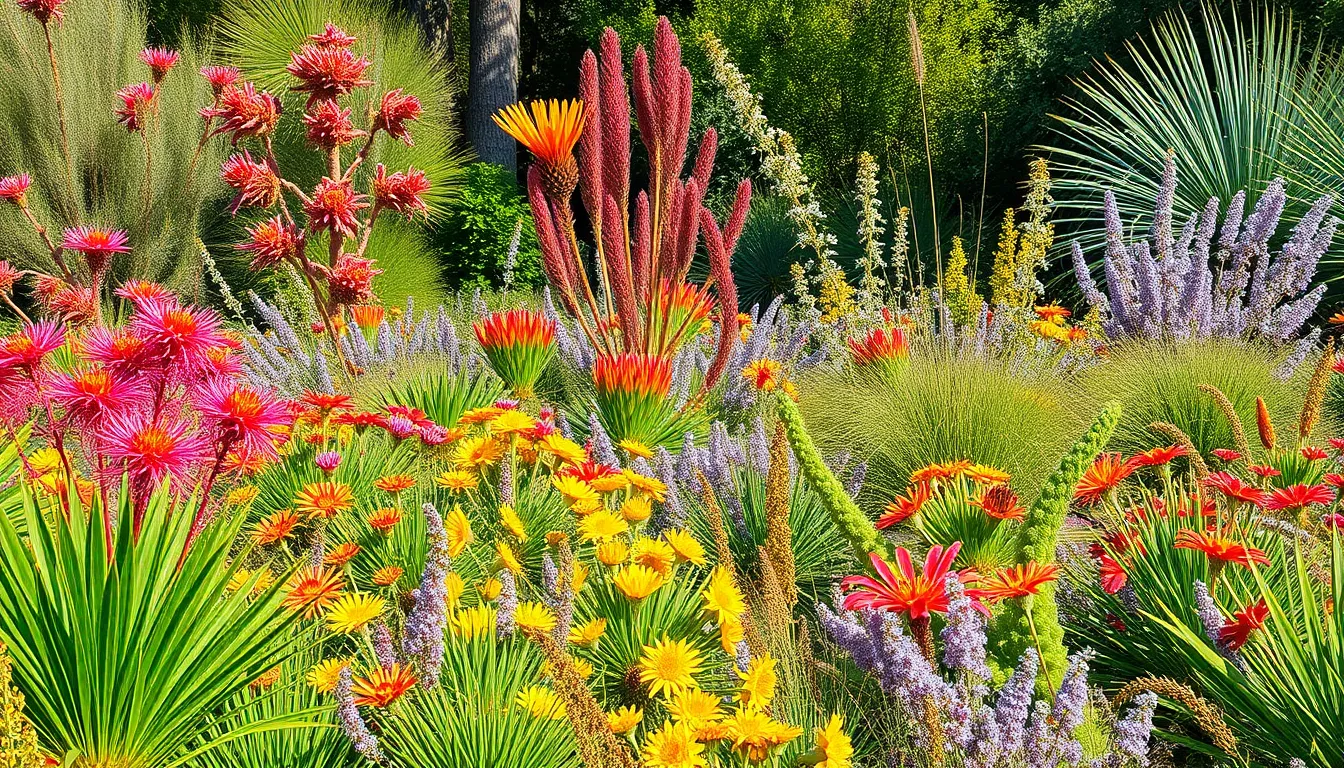
Creating habitats that support native wildlife extends our garden’s purpose beyond visual beauty. We can transform our Australian native gardens into thriving ecosystems that provide food, shelter, and breeding grounds for local fauna.
Bird-Friendly Nectar Plants
Kangaroo Paw (Anigozanthos) serves as a prime nectar source for native birds seeking energy rich blooms. We recommend planting these striking plants in clusters to create feeding stations that attract honeyeaters and lorikeets throughout the flowering season.
Grevillea varieties offer year round nectar production for countless bird species including wrens and wattlebirds. Different Grevillea species bloom at various times, so we suggest combining multiple varieties to ensure continuous food sources for our feathered visitors.
Banksia species provide both nectar from their distinctive flower spikes and protein rich seeds for parrots and cockatoos. These architectural plants create natural perching spots while offering dual food sources that support diverse bird populations.
Butterfly Garden Sections
Native grasses like Lomandra longifolia create essential shelter zones where butterflies can rest and reproduce. We position these hardy grasses in sunny areas where butterflies can bask while remaining protected from strong winds.
Flowering plants including Kangaroo Paw and Grevillea attract adult butterflies seeking nectar for energy and egg laying sites. Grouping these plants together creates butterfly highways that encourage regular visits and extended feeding opportunities.
Mixed height plantings provide landing platforms at different levels, accommodating various butterfly species with different flight patterns. We incorporate low ground covers alongside taller shrubs to create vertical diversity that butterflies navigate naturally.
Native Bee Pollinator Zones
Wattle (Acacia spp.) produces abundant pollen rich flowers that support native bee colonies during peak foraging seasons. These fast growing plants establish quickly and provide reliable food sources for solitary bees and social species alike.
Finger Limes (Citrus australasica) offer concentrated nectar that native bees collect efficiently from their small white flowers. We plant these productive shrubs near vegetable gardens where bee pollination enhances crop yields while supporting native bee populations.
Eucalyptus species supply consistent nectar flows from their distinctive flowers, supporting large bee communities throughout extended blooming periods. Different Eucalyptus varieties flower at staggered times, ensuring our native bees have continuous food sources across seasons.
Incorporate Water-Wise Rock Gardens With Succulents

Rock gardens create stunning focal points in native landscapes while requiring minimal water and maintenance. We can enhance these spaces by carefully selecting Australian succulent species that complement the natural stone features.
Pigface for Coastal-Inspired Groundcover
Pigface (Carpobrotus glaucescens) transforms rocky areas into vibrant coastal displays with its exceptional salt tolerance and poor soil adaptability. This resilient succulent forms dense mats that cascade beautifully over rocks and slopes, creating natural groundcover that requires virtually no irrigation once established. We love how its bright purple or yellow daisy-like flowers bloom from spring through autumn, adding seasonal color to harsh industry conditions.
Dense coverage develops quickly as Pigface spreads through trailing stems that root at nodes. Its thick, triangular leaves store water efficiently, making it perfect for exposed rocky areas where other plants struggle. Coastal gardeners particularly benefit from this plant’s ability to withstand salt spray and strong winds while preventing soil erosion on sloped rock gardens.
Native Violets for Delicate Accents
Native Violets (Viola hederacea) bring subtle elegance to shaded rock crevices with their delicate purple and white blooms. These charming groundcover plants thrive in the cooler microclimates created by large rocks and stone formations. We recommend tucking them into gaps between boulders where morning sun filters through but afternoon heat gets blocked.
Small heart-shaped leaves create soft carpets that contrast beautifully with harsh stone textures. Their tiny flowers appear almost year-round in favorable conditions, providing gentle color without overwhelming bold rock features. These violets spread slowly through runners, naturally filling spaces between stones while remaining easy to control if they venture beyond desired boundaries.
Sturt’s Desert Pea for Dramatic Impact
Sturt’s Desert Pea (Swainsona formosa) creates breathtaking focal points with its distinctive red and black claw-shaped flowers rising above silver-gray foliage. This iconic South Australian floral emblem demands attention when planted against neutral-colored rocks or gravel mulch. We position these striking plants where their unique blooms can be appreciated from multiple viewing angles throughout the garden.
Dramatic flower displays emerge on long stems during spring and early summer, with each bloom resembling a bird in flight. Well-draining rocky soils suit this plant perfectly, as it naturally occurs in arid regions where water drains quickly after rain. Their silvery leaves provide attractive structure even when not flowering, maintaining visual interest in rock garden compositions year-round.
Plan Seasonal Interest With Deciduous Native Trees
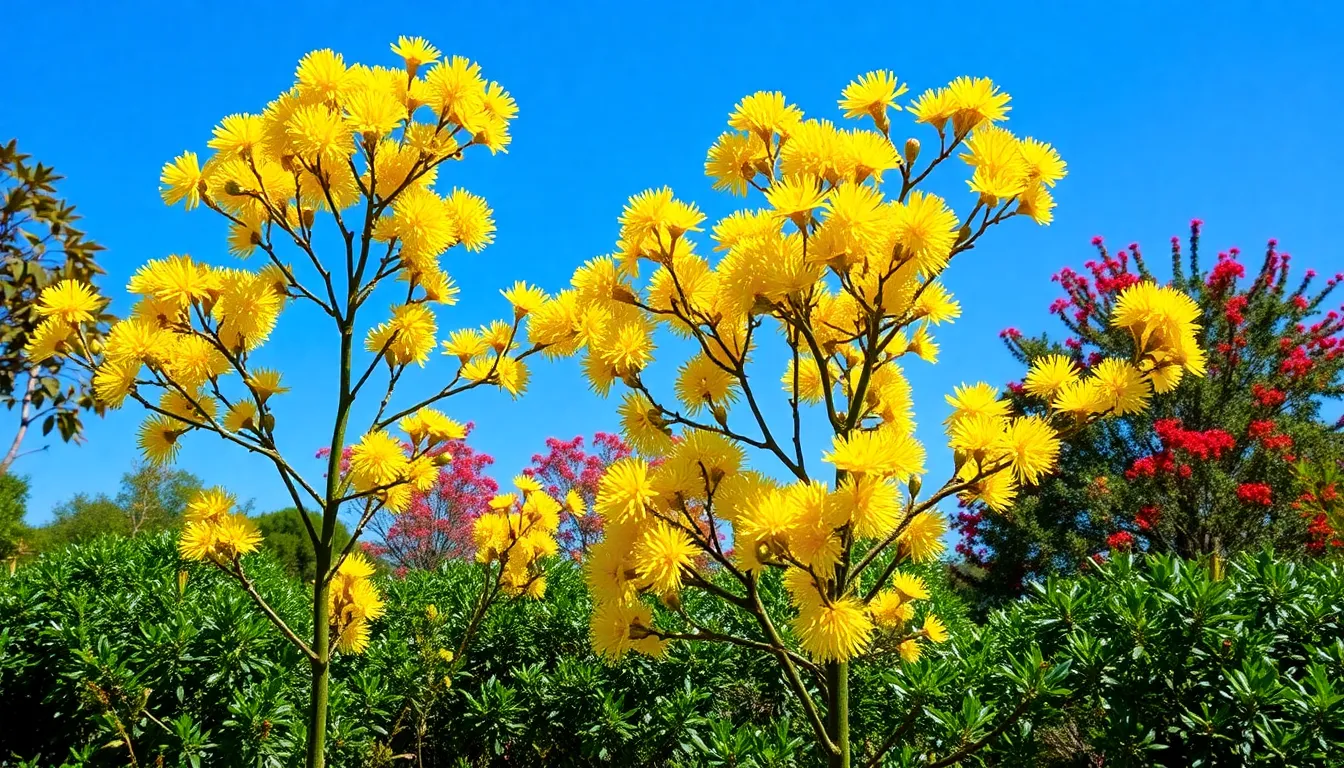
Creating year-round visual appeal in your native garden becomes effortless when you incorporate deciduous trees that showcase Australia’s seasonal beauty. These carefully selected species transform your industry throughout the year while maintaining the authentic character of native gardening.
Flame Trees for Autumn Spectacle
Flame Trees (Brachychiton acerifolius) deliver one of Australia’s most dramatic autumn displays with their vibrant red blooms that create a stunning canopy spectacle. We recommend positioning these magnificent trees as focal points in your garden design since their brilliant crimson flowers appear just as the cooler months arrive.
These native giants thrive in subtropical and temperate climates and can reach heights of 35 meters in ideal conditions. Position them where their autumn show won’t be overshadowed by other plantings, allowing their fiery display to command attention across your entire industry.
Plant flame trees in well-draining soil with plenty of space for their extensive root system to develop. Their drought tolerance once established makes them perfect for low maintenance native gardens that still deliver high visual impact.
Golden Wattle for Spring Blooms
Golden Wattle (Acacia pycnantha) serves as Australia’s national floral emblem and transforms gardens into golden showcases during spring blooming season. We’ve found that clustering multiple wattles creates the most impressive display while supporting native bee populations that emerge with warmer weather.
These fast-growing natives produce masses of fragrant yellow flowers from August through October, depending on your climate zone. Space them 3 to 4 meters apart to allow for their mature spread while creating a continuous golden canopy effect.
Establish golden wattles in full sun positions where their spring blooms can catch morning light and create dramatic shadows throughout the day. Their ability to fix nitrogen in the soil benefits surrounding native plants while reducing your garden’s fertilizer requirements.
Paper Bark Trees for Winter Structure
Paper Bark Trees (Melaleuca species) provide striking architectural elements during winter months when their distinctive white, papery bark becomes the garden’s focal point. We particularly value these natives for their ability to thrive in wet conditions while maintaining visual interest year round.
Choose from over 200 Melaleuca species to find varieties that suit your exact climate and soil conditions. Popular options include the Broad-leaved Paperbark (Melaleuca quinquenervia) for larger spaces and the Flax-leaved Paperbark (Melaleuca linariifolia) for more compact gardens.
Position these versatile natives near water features or in naturally wet areas where other trees might struggle. Their winter structure creates perfect nesting sites for native birds while their spring and summer flowers provide nectar sources throughout the warmer months.
Create Functional Herb and Edible Native Gardens
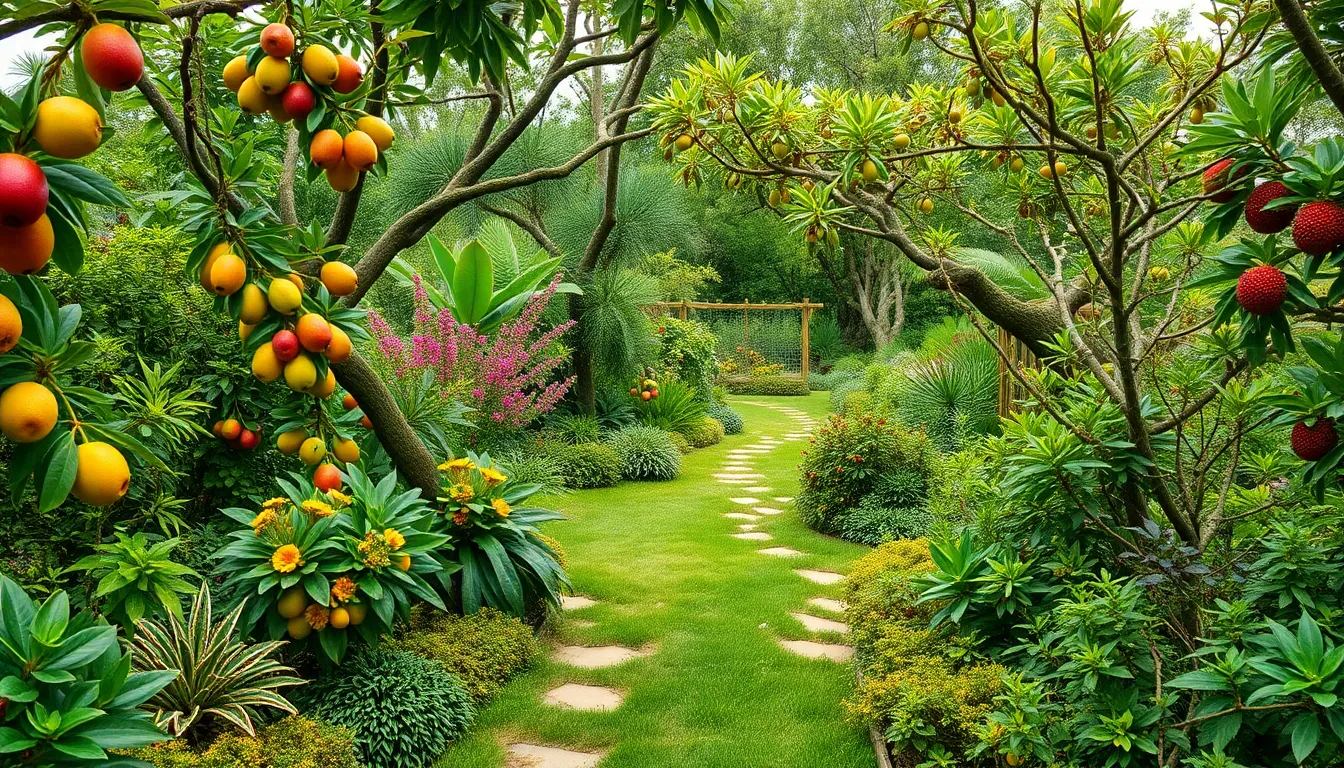
We’re transforming our native gardens into productive culinary spaces that combine stunning aesthetics with practical functionality. These edible landscapes offer us the perfect opportunity to grow unique Australian flavors while maintaining our commitment to native plant gardening.
Bush Tucker Plants for Culinary Adventures
Bush tucker plants bring authentic Aboriginal flavors directly to our kitchen tables while creating visually striking garden displays. Kakadu Plum delivers the industry’s highest vitamin C content and transforms ordinary desserts and sauces into nutritional powerhouses with its tangy flavor profile.
Finger Limes produce unique citrus pearls that modern Australian chefs prize for their burst of flavor and stunning visual appeal in gourmet dishes. We can harvest these lime caviar gems throughout the growing season for use in seafood dishes, cocktails, and dessert garnishes.
Quandong trees offer us the desert peach experience with their bright red fruits that create exceptional jams, sauces, and traditional bush food recipes. These drought tolerant trees thrive in challenging conditions where other fruit trees struggle to survive.
Midyim Berries provide sweet purple fruits perfect for homemade jams, desserts, and fresh eating while attracting native birds to our gardens. We plant these low growing shrubs as groundcover that produces food and supports local wildlife simultaneously.
Native Mint for Aromatic Pathways
Native mint varieties create fragrant walking experiences that naturally repel pests while providing culinary ingredients for our kitchen adventures. River Mint releases intense aromatic oils when brushed against, making pathway borders come alive with every footstep we take through the garden.
Peppermint Bush spreads quickly to form dense aromatic carpets that suppress weeds and create natural pest barriers around our edible garden beds. We harvest fresh leaves throughout the year for herbal teas, cooking, and natural insect repellent applications.
These hardy mint species thrive in various soil conditions and require minimal maintenance once established in our garden pathways. Stepping stones placed strategically through mint plantings encourage interaction with these fragrant plants while protecting their root systems.
Lemon Myrtle for Fragrant Cooking
Lemon Myrtle stands out as our most versatile native herb, delivering intense citrus flavor that surpasses traditional lemons in both aroma and taste intensity. Lemon Myrtle Leaves contain citral compounds that create exceptional marinades, desserts, and tea blends with their powerful lemony essence.
We grow these attractive shrubs as focal points in our herb gardens where their glossy green foliage and small white flowers provide year round visual interest. Fresh leaves can be harvested continuously for cooking while dried leaves maintain their potency for months in storage.
These adaptable plants thrive in partial shade conditions where other citrus plants struggle, making them perfect for filling challenging garden spaces with productive growth. We incorporate Lemon Myrtle into potpourri blends and natural cleaning products alongside our culinary applications for maximum garden to home utility.
Design Low-Maintenance Groundcover Solutions
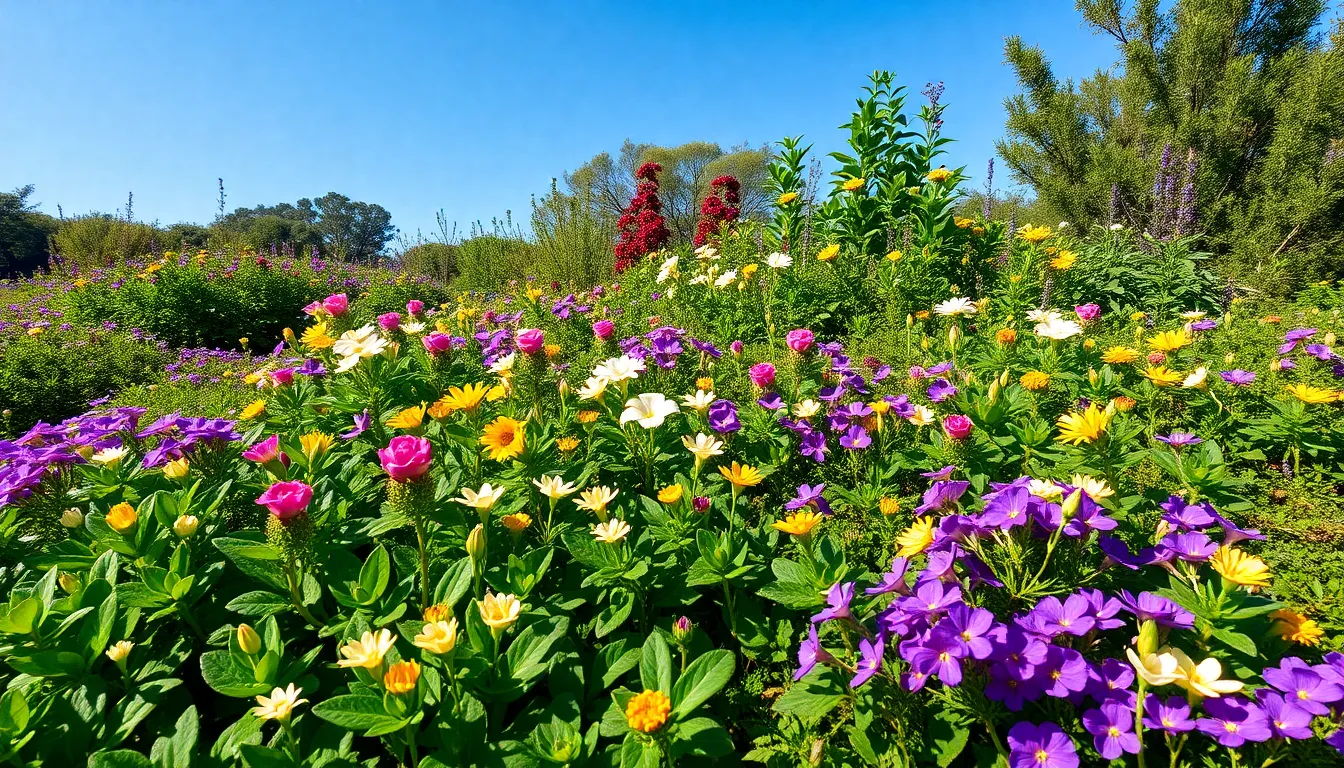
We’ll explore native groundcover options that create stunning garden foundations while requiring minimal ongoing care. These hardy Australian species thrive in challenging conditions and establish beautiful carpet effects across diverse industry areas.
Native Violets for Shaded Areas
Viola hederacea spreads naturally in cooler garden zones where other plants struggle to establish. This native violet creates lush green coverage that transforms shadowy spaces into vibrant living carpets. We recommend planting these violets in clusters of 5-7 plants spaced 30cm apart for optimal coverage within the first growing season.
Dense foliage emerges quickly once viola hederacea establishes its root system in moist soil conditions. Small purple or white flowers appear throughout spring and autumn, adding delicate color accents to shaded garden areas. Water requirements remain minimal after the first year, making this groundcover perfect for low maintenance shade gardens.
Maintenance involves occasional trimming to prevent excessive spreading into neighboring plant zones. We suggest checking growth boundaries every 3-4 months during active growing seasons. This native violet tolerates foot traffic well, making it suitable for pathways through shaded garden areas.
Creeping Boobialla for Coastal Gardens
Myoporum parvifolium thrives in harsh coastal conditions where salt spray and sandy soils challenge most garden plants. This spreading groundcover establishes dense mats that reach 2-3 meters wide while staying low at 10-15cm height. We’ve observed excellent performance in gardens within 5km of coastlines where salt tolerance becomes essential.
Spreading occurs rapidly once creeping boobialla adapts to coastal garden conditions during its first season. Small white or pink flowers appear throughout warmer months, attracting native bees and beneficial insects to coastal landscapes. Root systems develop extensively, providing excellent erosion control on sandy slopes and embankments.
Pruning requirements stay minimal with occasional shaping to maintain desired boundaries around established plants. We recommend annual light trimming in late winter to encourage fresh growth and maintain compact form. This coastal groundcover handles drought conditions exceptionally well once established in sandy garden soils.
Billy Buttons for Sunny Meadow Effects
Craspedia globosa produces distinctive spherical yellow flowers that create stunning meadow displays in full sun locations. These native perennials reach 30-60cm height with silver gray foliage that contrasts beautifully against the bright golden blooms. We suggest mass plantings of 15-20 plants per square meter for maximum visual impact in open garden areas.
Flowering continues for 4-6 months during spring and summer seasons when billy buttons receive adequate sunlight exposure. Ball shaped blooms measure 2-3cm diameter and work excellently as cut flowers for indoor arrangements. Seed heads remain attractive even after flowering, extending the ornamental period through autumn months.
Growing requirements include well draining soil and minimal water once plants establish their extensive root systems. We recommend avoiding heavy clay soils and ensuring good drainage to prevent root rot issues. These meadow plants self seed readily, creating natural colonies that expand coverage without additional planting efforts.
Establish Windbreak Protection Using Hardy Natives
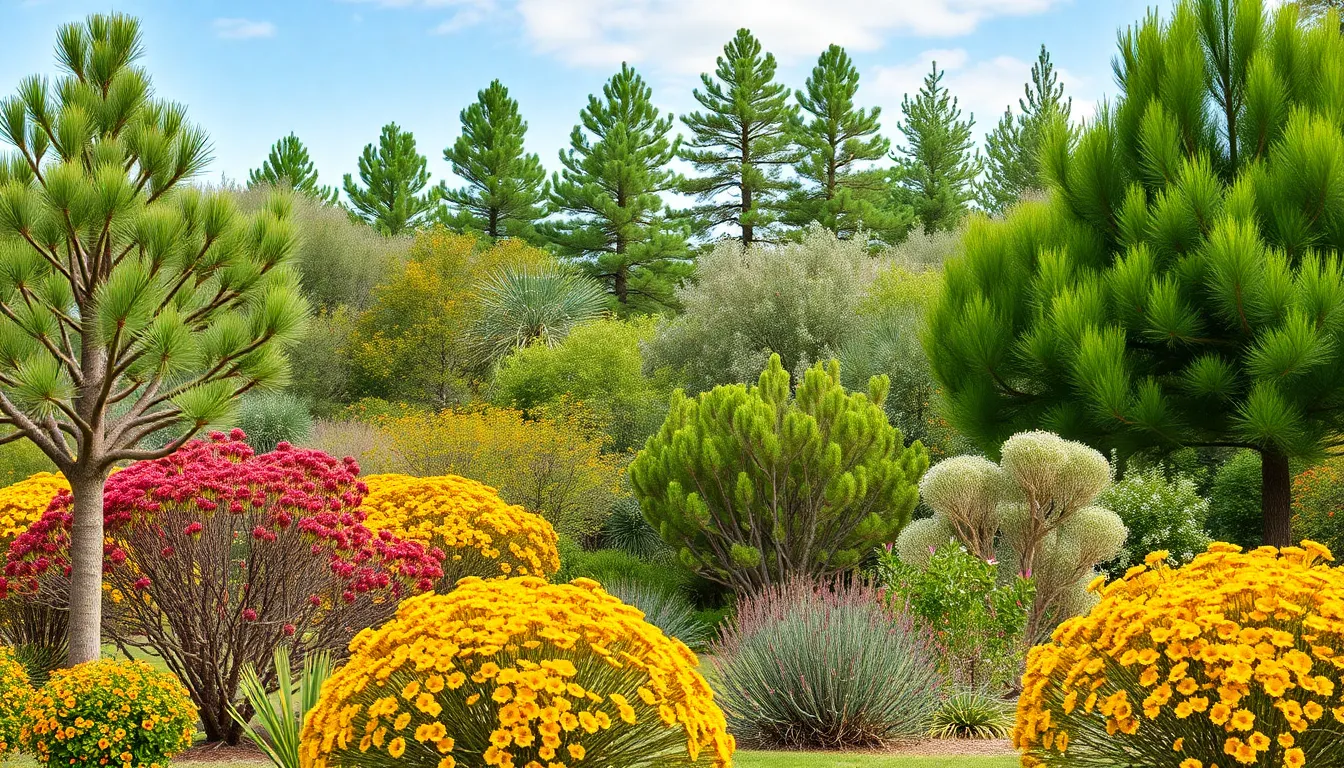
Creating effective windbreaks with native plants protects our gardens from harsh winds while maintaining the authentic Australian character we’ve been building. We’ll explore three exceptional native options that provide robust protection in different environments.
Casuarina Trees for Coastal Properties
Casuarina cristata stands as our top choice for coastal windbreak protection due to its remarkable ability to withstand strong winds and saline conditions. These hardy trees develop dense, needle-like foliage that creates an effective barrier against salt-laden coastal breezes while helping stabilize sandy soils.
We recommend planting Casuarina trees in staggered rows approximately 3-4 meters apart to maximize wind protection coverage. Their fast growth rate means we’ll see substantial windbreak benefits within 2-3 years of establishment, making them ideal for new coastal properties requiring immediate protection.
The trees’ natural drought tolerance reduces maintenance requirements once established, requiring watering only during extended dry periods. Their distinctive drooping branchlets create an attractive weeping effect that adds visual interest while filtering wind rather than creating turbulent air pockets.
Acacia Species for Inland Gardens
Acacia melanoxylon and Acacia ligulata serve as robust natural barriers for inland properties where coastal species might struggle with different soil and climate conditions. These Acacia varieties develop thick, bushy growth patterns that effectively deflect wind while attracting native wildlife with their seasonal flowering displays.
We suggest establishing Acacia windbreaks in double rows with plants spaced 2-3 meters apart for optimal density and protection. Their deep root systems help prevent soil erosion on slopes while their hardy nature ensures survival during drought conditions common in inland areas.
The species’ natural ability to fix nitrogen in soil improves growing conditions for surrounding plants, creating a beneficial network effect beyond wind protection. Their golden yellow flowers provide stunning seasonal displays that enhance garden aesthetics while serving practical windbreak functions.
Native Pine for Evergreen Screening
Callitris rhomboidea (Port Jackson Pine) offers year-round foliage coverage that maintains consistent windbreak protection through all seasons. These evergreen natives develop dense, conical shapes that create effective wind barriers while providing attractive vertical elements in our garden design.
We position Native Pines as permanent windbreak anchors, spacing them 4-5 meters apart to accommodate their mature spread while ensuring continuous coverage. Their slow but steady growth creates long-term windbreak answers that require minimal maintenance once established.
The trees’ distinctive blue-green foliage and small woody cones add textural interest to windbreak plantings while their natural pest resistance reduces ongoing care requirements. Their ability to thrive in various soil types makes them versatile options for different inland garden conditions.
Conclusion
We’ve explored the incredible diversity and practicality that Australian native gardens offer homeowners seeking sustainable landscaping answers. From drought-tolerant grasses to vibrant flowering displays these plants create stunning outdoor spaces while supporting local ecosystems.
The versatility of native species means you can achieve any garden style you envision. Whether you’re establishing privacy screens creating wildlife habitats or developing productive bush tucker gardens there’s a native plant perfectly suited to your needs.
Most importantly these gardens reward us with reduced maintenance costs lower water bills and the satisfaction of supporting Australia’s unique biodiversity. Your native garden becomes more than just beautiful landscaping—it’s an active contribution to environmental conservation that will thrive for generations to come.
Frequently Asked Questions
What are the main benefits of creating an Australian native garden?
Australian native gardens offer several key advantages: they require significantly less water than traditional European plants, are naturally adapted to Australia’s climate, support local wildlife, and provide low-maintenance landscaping solutions. These gardens also reduce environmental impact while offering creative design possibilities without sacrificing style or color.
Which native grasses are best for sustainable Australian gardens?
The top native grasses include Kangaroo grass for its drought tolerance and elegant appearance, Lomandra species for low-maintenance borders that thrive in various conditions, and Wallaby grass for slope stabilization and erosion control. These grasses form excellent foundations for resilient landscapes when planted using proper techniques.
What native flowering plants provide the best color displays?
Australia offers over 800 Wattle species and 700 Eucalyptus varieties for vibrant landscaping. Grevillea varieties provide year-round color, Banksia species create dramatic architectural focal points, and Waratah delivers striking crimson flowers. Grouping different species ensures continuous blooms and maximizes visual impact while attracting wildlife.
How can I create privacy screens using native plants?
Effective native privacy screens include Lilly Pilly for dense evergreen coverage, Bottlebrush for colorful wildlife-attracting barriers, and Native Fuchsia for shaded areas. These shrubs provide functional boundaries while maintaining native gardening principles. Proper spacing and regular trimming ensure optimal growth and screening effectiveness.
How do native gardens support local wildlife?
Native gardens create thriving ecosystems by providing food, shelter, and breeding grounds. Bird-friendly plants like Kangaroo Paw and Grevillea attract native birds, while native grasses and flowering plants support butterfly populations. Wattle, Finger Limes, and Eucalyptus establish pollinator zones for native bees, ensuring continuous food sources.
What are the best water-wise plants for rock gardens?
Top water-wise native plants include Pigface for vibrant coastal groundcover with salt tolerance, Native Violets for delicate blooms in shaded areas, and Sturt’s Desert Pea for dramatic flower displays. These Australian succulents enhance landscapes while requiring minimal maintenance and water, perfect for sustainable rock gardens.
Can I grow edible plants in my native garden?
Yes! Native gardens can incorporate productive bush tucker plants like Kakadu Plum, Finger Limes, Quandong trees, and Midyim Berries. These edible natives offer unique flavors while attracting wildlife. Native mint varieties provide aromatic pathways and pest control, while Lemon Myrtle offers versatile culinary applications.
What are the best low-maintenance groundcover options?
Excellent native groundcover choices include Native Violets for shaded areas requiring minimal water, Creeping Boobialla for coastal gardens with salt tolerance and erosion control, and Billy Buttons for sunny meadows producing distinctive yellow flowers. These species thrive in challenging conditions with minimal maintenance requirements.
